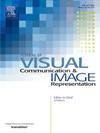UAT:Unsupervised object tracking based on graph attention information embedding
IF 2.6
4区 计算机科学
Q2 COMPUTER SCIENCE, INFORMATION SYSTEMS
Journal of Visual Communication and Image Representation
Pub Date : 2024-10-01
DOI:10.1016/j.jvcir.2024.104283
引用次数: 0
Abstract
An excellent unsupervised tracker includes a powerful base tracker and an effective unsupervised tracking strategy. However, most base trackers lack internal feature representations for information embedding processes. Most unsupervised trackers are not robust enough in complex environments and lack an effective template update strategy. We propose an unsupervised object tracking based on graph attention information embedding (UAT) to solve the above problems. UAT combines graph attention mechanism with multi-scale features to construct a multi-scale graph attention module (MGA). MGA module dynamically and efficiently completes the information embedding between the template branch and the search area branch. The response map obtained by fusing the feature maps of the two branches is more informative about the location of the target. An attention based information reinforcement update module (RUM) improves the robustness of the tracker. RUM enhances the representation of the feature map in both the spatial dimension and the channel dimension. Template features are also updated indirectly through information transfer between the two branches. RUM suppresses background interference and improves network perception during tracking. Experiments on challenging benchmarks such as VOT2018, VOT2019, TrackingNet, OTB100, LaSOT and UAV123 demonstrate that the proposed UAT achieves state-of-the-art performance in unsupervised trackers.
UAT:基于图注意信息嵌入的无监督物体跟踪
优秀的无监督跟踪器包括功能强大的基础跟踪器和有效的无监督跟踪策略。然而,大多数基础跟踪器缺乏用于信息嵌入过程的内部特征表示。大多数无监督跟踪器在复杂环境中不够稳健,而且缺乏有效的模板更新策略。为了解决上述问题,我们提出了一种基于图注意信息嵌入的无监督物体跟踪(UAT)。UAT 将图注意机制与多尺度特征相结合,构建了多尺度图注意模块(MGA)。MGA 模块动态、高效地完成了模板分支和搜索区域分支之间的信息嵌入。通过融合两个分支的特征图得到的响应图更能说明目标的位置。基于注意力的信息强化更新模块(RUM)提高了跟踪器的鲁棒性。RUM 增强了特征图在空间维度和信道维度上的表示。模板特征也通过两个分支之间的信息传递间接更新。RUM 可以抑制背景干扰,改善跟踪过程中的网络感知。在 VOT2018、VOT2019、TrackingNet、OTB100、LaSOT 和 UAV123 等具有挑战性的基准上进行的实验表明,所提出的 UAT 在无监督跟踪器中达到了最先进的性能。
本文章由计算机程序翻译,如有差异,请以英文原文为准。
求助全文
约1分钟内获得全文
求助全文
来源期刊

Journal of Visual Communication and Image Representation
工程技术-计算机:软件工程
CiteScore
5.40
自引率
11.50%
发文量
188
审稿时长
9.9 months
期刊介绍:
The Journal of Visual Communication and Image Representation publishes papers on state-of-the-art visual communication and image representation, with emphasis on novel technologies and theoretical work in this multidisciplinary area of pure and applied research. The field of visual communication and image representation is considered in its broadest sense and covers both digital and analog aspects as well as processing and communication in biological visual systems.
 求助内容:
求助内容: 应助结果提醒方式:
应助结果提醒方式:


